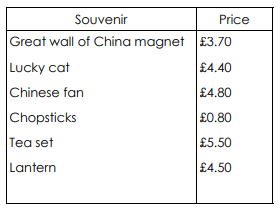Year 4
These resources will be removed by end of Summer Term 2025.
Switch to our new teaching resources now - designed by teachers and leading subject experts, and tested in classrooms.
These resources were created for remote use during the pandemic and are not designed for classroom teaching.
Lesson details
Key learning points
- In this lesson, we will develop our skills in planning how to solve, and then solving, a money problem using a trial and improvement strategy.
Licence
This content is made available by Oak National Academy Limited and its partners and licensed under Oak’s terms & conditions (Collection 1), except where otherwise stated.
3 Questions
Q1.
Apples cost £0.25, Oranges cost £0.35 and Lychees cost £0.45. Emily buys three fruits. What is the cheapest total cost?
£1.05
£1.5
Q2.
Apples cost £0.25, Oranges cost £0.35 and Lychees cost £0.45. Emily buys three fruits. What is the most expensive total cost?
£1.20
£1.25
Q3.
Apples cost £0.25, Oranges cost £0.35 and Lychees cost £0.45. Which of these choices would cost Emily more than £5.00?
3 of each fruit
4 of each fruit
6 Questions
Q1.
Annie buys the three most expensive items. How much money does she spend?

£13
£14.40
Q2.
How much change from £20.00 does Annie receive?
£5.00
£6.20
Q3.
Emily buys the three cheapest items. How much does she spend?
£8.00
£9.00
Q4.
How much change does Emily receive from £10.00?
£1.90
£2.10
Q5.
John spends £10 on two items. Which items does he buy?
Fan and lucky cat
Lucky cat and magnet
Q6.
James receives £1 change from £10. He buys three items. Which are they?
Fan, magnet, tea set
Lucky cat, tea set, lantern

